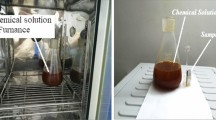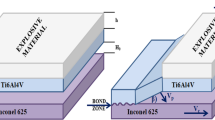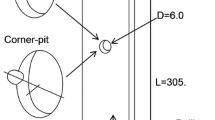Abstract
This research study presents a novel test fixture for tribocorrosion investigation in the internal dovetail slot of Ti6Al4V specimens. The experiments were carried out at room temperature under cyclic loads of 5 kN and 7.5 kN (R = 0.1) and a constant frequency of 20 Hz using a universal testing machine. Three environments were applied: dry, 3.5 % NaCl and phosphate buffered saline (PBS). Microscopic investigations revealed the presence of oxygen, chlorine and sodium in 3.5 % NaCl environment while phosphorous, chlorine, potassium, sodium and oxygen were observed in PBS environment in addition to the intense coloration, depicting pitting corrosion. Early initiation of the four edge cracks in shear mode, presence of a few minor cracks and longer crack propagations till crack arrest, was observed in corrosive environments. Numerical simulation using finite element analysis software; ABAQUS successfully predicted the mode of crack initiation, location of edge cracks and crack arrest phenomenon.
Similar content being viewed by others
Abbreviations
- F N :
-
Normal component of the contact force
- L :
-
Contact length
- E 1 :
-
Modulus of elasticity of Ti6Al4V
- ϑ 1 :
-
Poisson’s ratio of Ti6Al4V
- R 1 :
-
Radius of Ti6Al4V specimen
- E 2 :
-
Modulus of elasticity of carbide
- ϑ 2 :
-
Poisson’s ratio of carbide
- R 2 :
-
Radius of carbide rod
- P h :
-
Hertzian pressure
- b :
-
Contact width
- K II :
-
Stress intensity factor (mode-II)
- J :
-
J-integral
- τ max :
-
Maximum shear stress
References
D. Landolt, S. Mischler and M. Stemp, Electrochemical methods in tribocorrosion: a critical appraisal, Electrochimica acta, 46(24–25) (2001) 3913–3929, doi: https://doi.org/10.1016/S0013-4686(01)00679-X.
J. Chen et al., Corrosion and tribocorrosion behaviors of AISI 316 stainless steel and Ti6Al4V alloys in artificial seawater, Transactions of Nonferrous Metals Society of China, 24(4) (2014) 1022–1031, doi:https://doi.org/10.1016/S1003-6326(14)63157-5.
V. Swaminathan and J. L. Gilbert, Fretting corrosion of CoCrMo and Ti6Al4V interfaces, Biomaterials, 33(22) (2012) 5487–5503, doi:https://doi.org/10.1016/j.biomaterials.2012.04.015.
S. Barril, S. Mischler and D. Landolt, Influence of fretting regimes on the tribocorrosion behaviour of Ti6Al4V in 0.9 wt.% sodium chloride solution, Wear, 256(9–10) (2004) 963–972, doi: https://doi.org/10.1016/j.wear.2003.11.003.
C. Yu et al., Oxidation and H2O/NaCl-induced corrosion behavior of sputtered Ni-Si coatings on Ti6Al4V at 600–650 °C, Surface and Coatings Technology, 201(16–17) (2007) 7530–7537, doi: https://doi.org/10.1016/j.surfcoat.2007.02.022.
P. Henry, J. Takadoum and P. Berçot, Tribocorrosion of 316L stainless steel and TA6V4 alloy in H2SO4 media, Corrosion Science, 51(6) (2009) 1308–1314, doi: https://doi.org/10.1016/j.corsci.2009.03.015.
B. Davoren, E. Ferg and D. Hattingh, Tribocorrosion of friction-stir-welded Ti6AL4V in 3.5 % NaCl aqueous solution, Wear, 390 (2017) 246–252, doi: https://doi.org/10.1016/j.wear.2017.08.004.
H. Guleryuz and H. Cimenoglu, Oxidation of Ti-6Al-4V alloy, Journal of Alloys and Compounds, 472(1–2) (2009) 241–246, doi: https://doi.org/10.1016/j.jallcom.2008.04.024.
V. B. Chintada, R. Koona and M. Raju Bahubalendruni, State of art review on nickel-based electroless coatings and materials, Journal of Bio-and Tribo-Corrosion, 7(4) (2021) 1–14, doi: https://doi.org/10.1007/s40735-021-00568-7.
S. A. Umoren et al., A critical review on the recent studies on plant biomaterials as corrosion inhibitors for industrial metals, Journal of Industrial and Engineering Chemistry, 76 (2019) 91–115, doi: https://doi.org/10.1016/j.jiec.2019.03.057.
C. D. Lykins, S. Mall and V. Jain, An evaluation of parameters for predicting fretting fatigue crack initiation, International Journal of Fatigue, 22(8) (2000) 703–716, doi: https://doi.org/10.1016/S0142-1123(00)00036-0.
N. A. Bhatti and M. Abdel Wahab, Fretting fatigue crack nucleation: a review, Tribology International, 121 (2018) 121–138, doi: https://doi.org/10.1016/j.triboint.2018.01.029.
J. Ding et al., Fretting fatigue predictions in a complex coupling, International Journal of Fatigue, 29(7) (2007) 1229–1244, doi: https://doi.org/10.1016/j.ijfatigue.2006.10.017.
H. Proudhon and S. Basseville, Finite element analysis of fretting crack propagation, Engineering Fracture Mechanics, 78(4) (2011) 685–694, doi: https://doi.org/10.1016/j.engfracmech.2010.11.016.
M. P. Szolwinski and T. N. Farris, Observation, analysis and prediction of fretting fatigue in 2024-T351 aluminum alloy, Wear, 221(1) (1998) 24–36, doi: https://doi.org/10.1016/S0043-1648(98)00264-6.
B. P. Conner et al., Application of a fracture mechanics based life prediction method for contact fatigue, International Journal of Fatigue, 26(5) (2004) 511–520, doi: https://doi.org/10.1016/j.ijfatigue.2003.09.003.
D.-S. Wei, S.-H. Yuan and Y.-R. Wang, Failure analysis of dovetail assemblies under fretting load, Engineering Failure Analysis, 26 (2012) 381–396, doi: https://doi.org/10.1016/j.engfailanal.2012.06.007.
V. Pejaković, V. Totolin and M. R. Ripoll, Tribocorrosion behaviour of Ti6Al4V in artificial seawater at low contact pressures, Tribology International, 119 (2018) 55–65, doi: https://doi.org/10.1016/j.triboint.2017.10.025.
I. Simsek and D. Ozyurek, Investigation of the wear and corrosion behaviors of Ti5Al2.5Fe and Ti6Al4V alloys produced by mechanical alloying method in simulated body fluid environment, Materials Science and Engineering: C, 94 (2019) 357–363, doi: https://doi.org/10.1016/j.msec.2018.09.047.
E. J. Hearn, Mechanics of Materials 2: The Mechanics of Elastic and Plastic Deformation of Solids and Structural Materials, Elsevier (1997).
ASTM International, ASTM E399-05 Standard Test Method for Plane-strain Fracture Toughness of Metallic Materials, Annual Book of ASTM Standards, Philadelphia PA: American Society for Testing and Materials (2005).
M. Aziz-Kerrzo et al., Electrochemical studies on the stability and corrosion resistance of titanium-based implant materials, Biomaterials, 22(12) (2001) 1531–1539, doi: https://doi.org/10.1016/S0142-9612(00)00309-4.
Z. Anjum et al., Prediction of non-propagating fretting fatigue cracks in Ti6Al4V sheet tested under pin-in-dovetail configuration: experimentation and numerical simulation, Materials and Design, 87 (2015) 750–758, doi: https://doi.org/10.1016/j.matdes.2015.08.070.
N. Noraphaiphipaksa et al., Fretting-contact-induced crack opening/closure behaviour in fretting fatigue, International Journal of Fatigue, 88(Supplement C) (2016) 185–196, doi: https://doi.org/10.1016/j.ijfatigue.2016.03.029.
N. Noraphaiphipaksa, C. Kanchanomai and Y. Mutoh, Numerical and experimental investigations on fretting fatigue: Relative slip, crack path, and fatigue life, Engineering Fracture Mechanics, 112 (2013) 58–71, doi: https://doi.org/10.1016/j.engfracmech.2013.10.007.
F. Mukhtar et al., Effect of chrome plating and varying hardness on the fretting fatigue life of AISI D2 components, Wear, 418 (2019) 215–225, doi: https://doi.org/10.1016/j.wear.2018.12.001.
H. Jiang et al., Fatigue degradation after salt spray ageing of electromagnetically riveted joints for CFRP/Al hybrid structure, Materials and Design, 142 (2018) 297–307, doi: https://doi.org/10.1016/j.matdes.2018.01.047.
P. C. Zhao et al., Very high-cycle fatigue behaviour of T i-6 A l-4 V alloy under corrosive environment, Fatigue and Fracture of Engineering Materials and Structures, 41(4) (2018) 881–893, doi: https://doi.org/10.1111/ffe.12735.
T. Chapman et al., Environmentally assisted fatigue crack nucleation in Ti-6Al-2Sn-4Zr-6Mo, Corrosion Science, 96 (2015) 87–101, doi: https://doi.org/10.1016/j.corsci.2015.03.013.
J. Kim, E. Plancher and C. C. Tasan, Hydrogenation-induced lattice expansion and its effects on hydrogen diffusion and damage in Ti-6Al-4V, Acta Materialia, 188 (2020) 686–696, doi: https://doi.org/10.1016/j.actamat.2020.02.029.
R. Liu et al., A primary study of the effect of hydrostatic pressure on stress corrosion cracking of Ti-6Al-4V alloy in 3.5 % NaCl solution, Corrosion Science, 165 (2020) 108402, doi: https://doi.org/10.1016/j.corsci.2019.108402.
E. Saunders et al., Understanding the “blue spot”: sodium chloride hot salt stress-corrosion cracking in titanium-6246 during fatigue testing at low pressure, Engineering Failure Analysis, 61 (2016) 2–20, doi: https://doi.org/10.1016/j.engfailanal.2015.06.008.
H. Gu et al., Crack behavior of Ti-6Al-4V alloy combined conformal contact fretting, non-conformal contact fretting and simple fatigue, International Journal of Fatigue (2020) 105741, doi: https://doi.org/10.1016/j.ijfatigue.2020.105741.
Acknowledgments
The research facilities provided at Fracture Mechanics and Fatigue Laboratory, Department of Mechanical Engineering, UET Taxila, Punjab, Pakistan are greatly acknowledged. We also acknowledge the collaborations with Dr. Mohammad Mujahid, Dr. Mushtaq Khan, Dr. Aneela Wakeel and Engr. Faisal Qayyum during this research work.
Author information
Authors and Affiliations
Corresponding author
Additional information
Zeeshan Anjum completed his B.Sc. in Mechanical Engineering from UAJK Muzaffarabad in 2011. He passed his M.Sc. in Applied Mechanics and Design from UET Taxila, Pakistan in 2014 and he is currently doing his Ph.D. from the same university.
Sayyid Masoodur Rahman Shah (Masood Shah) is the Ph.D. supervisor of Zeeshan Anjum. He completed his B.Sc. in Mechanical Engineering from UET Taxila, Pakistan, M.Sc. and Ph.D. in Mechanical Engineering from Ecole des Mines d’Albi — Carmaux — ALBI — France.
Rights and permissions
About this article
Cite this article
Anjum, Z., Shah, M. Prediction of crack initiation and propagation during fretting corrosion of novel Ti6Al4V specimens in saline and physiological environments. J Mech Sci Technol 37, 119–126 (2023). https://doi.org/10.1007/s12206-022-1212-5
Received:
Revised:
Accepted:
Published:
Issue Date:
DOI: https://doi.org/10.1007/s12206-022-1212-5




